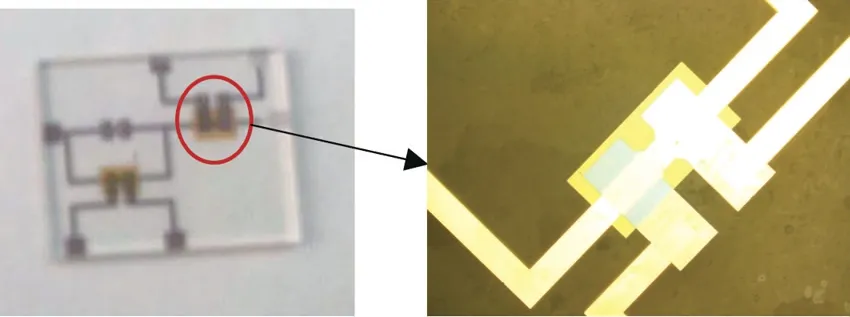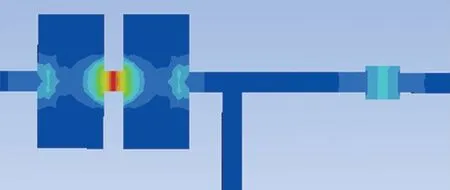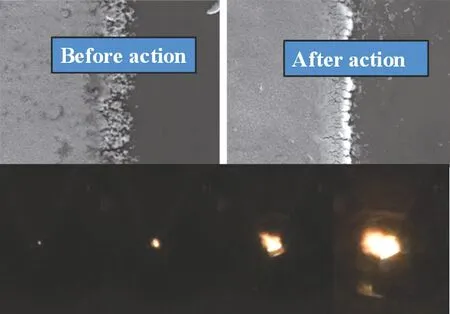Research on Safe Detonation Chip Technology Based on MEMS Technology
,,,,,
(Shaanxi Applied Physics and Chemistry Research Institute,Xi’an Shaanxi 710061,China)
Abstract:Aiming at the safety problem of MEMS low-energy pyrotechnics,this paper designs a MEMS safety detonation chip based on the MEMS switch,including Ni-Cr micro heater layer,insulation layer and circuit layer. Physical characterization,simulation analysis and safety ignition performance test were carried out. The experimental results display that the MEMS switch realizes on-off conversion successfully. Accordingly,the safety ignition chip improves the ignition safety while firing reliably at low energy,and the full ignition current is 0.8 A,the full ignition voltage is 7 V,the action time is 22 μs. It provides effective support for the safety technology of MEMS low-energy pyrotechnics.
Key words:MEMS technology;safety detonation chip;MEMS switch;Ni-Cr heater;performance test
MEMS Pyrotechnics is the product of the combination of MEMS(Micro Electro-Mechanical Systems)technology,micro-nano material technology and pyrotechnics technology. The characteristics of MEMS pyrotechnic products are the pyrotechnic products with the scale of the transducing structure and the medicament structure in the order of micrometers,the core device in the millimeter scale conducted extensive research on the safety technology of MEMS pyrotechnic products[1-4]. In 2004,the US patent proposed a method for the safety control of semiconductor bridge initiating devices by integrating inductors,circuits,and capacitive elements,to filter stray currents and electromagnetic signals,and improve the safety of initiating devices[5-7]. In 2010,the French LAAS-CNRS laboratory proposed the design of chipbased pyrotechnic products,integrating MEMS switches with pyrotechnic chips to improve the safety of pyrotechnic products[8]. In 2015,Weapon 213 reported a MEMS electrothermal normally closed switch device,which can achieve integrated integration with MEMS pyrotechnic chips and at the same time can improve the safety of MEMS pyrotechnic products[9-12]. How to improve the safety of MEMS pyrotechnic products under the conditions of low energy,miniaturization and integration is one of the development directions of MEMS pyrotechnic products.
This article focuses on the safety problems caused by the low energy,miniaturization and integration of MEMS pyrotechnic products,and designs a safety initiation chip based on MEMS technology. It integrates the safety initiation chip by MEMS technology and the safety initiation performance was tested and analyzed.
1 Safe detonation chip design
1.1 Security problem analysis
With the first generation of mechanical pyrotechnic products (fire caps, needle detonators,etc.),the second generation of electric pyrotechnic products(bridge wire,bridge charged pyrotechnic products, etc.) to the third generation of nonlinear pyrotechnic products(explosion foil,laser explosives,etc.)technology development,the safety of explosives gradually improves with the development of the mechanism of explosives[13],but in practical applications,it still cannot meet the safety requirements of weapon systems. In order to prevent the inadvertent action of pyrotechnic products in complex environments,it is often used to increase the safety by adding mechanical partitions and making circuits to discharge static electricity. The fourth generation of smart pyrotechnic products represented by MEMS pyrotechnic products has the characteristics of low energy,miniaturization and modularization[6]. The chemicals used mostly sensitive detonators(such as copper azide)are making the safety of MEMS pyrotechnic products greatly reduced. Traditional safety measures such as installing mechanical partitions,making circuits,and installing diodes are incompatible with MEMS pyrotechnics processes and functions in terms of processing technology,volume modules,and integration. Traditional safety measures cannot be used in MEMS pyrotechnics.
1.2 Safe detonation chip design
The safety initiation chip based on the MEMS process is controlled by the MEMS planar switch and the logic circuit to complete the on-off conversion of the MEMS planar switch,to realize the safety control of the initiation and energy conversion element, and to improve the safety of the safety initiation chip. The safety chip is usually grounded at both ends to ensure safety. When the initiating transducing element needs to function,the MEMS planar switch realizes on-off conversion,interrupting the short-circuit protection of the initiating transducing element,and the electrical energy is applied to the initiating transducing element to achieve the initiating effect under special circumstances,it is necessary to invalidate the detonating transducer and the MEMS planar switch functions permanently cut off the energy source of the detonating transducer and realize the fireproof function.
The safety initiation chip based on the MEMS process is composed of an initiation transducer and two independent MEMS planar switches. The specific structure diagram is shown in Fig. 2.

Fig.2 Schematic diagram of the safety initiation chip structure
2 Safety initiation chip integration and characterization analysis
This section may be divided by subheadings. It should provide a concise and precise description of the experimental results,their interpretation as well as the experimental conclusions that can be drawn. Authors should discuss the results and how they can be interpreted in perspective of previous studies and of the working hypotheses. The findings and their implications should be discussed in the broadest context possible. Future research directions may also be highlighted.
2.1 Integrated production
The production of the safety detonation chip mainly includes the production of the microstructure transducer layer,the insulation layer,and the logic circuit layer.
The production process of the microstructure transducing element layer:①Cleaning Pyrex glass substrate;②Unbalanced magnetron sputtering Ni-Cr film;③Processes such as homogenization,photolithography,development,etc. form the pattern structure of the transducing element;④The etching solution is etched and cleaned to obtain Ni-Cr transducers.
Insulation layer production process:①Vapor deposition of Si3N4film;②Uniform glue,hard film,photolithography,and development form an insulating layer pattern structure;③Si3N4insulating layer pattern is produced by dry etching,and washed to obtain the insulating layer pattern.
The production process of the logic circuit layer:①Unbalanced magnetron sputtering Cu film;②Uniform glue,hard film,photolithography,and development form a wire layer structure;③The etching solution is etched and cleaned to obtain a Cu wire layer.
The fabricated safety detonation chip is shown in Fig.3.

Fig.3 Integrated integration of safety initiation chip and single MEMS planar switch
2.2 Performance characterization
The key original components of the micro initiation device were tested by laser confocal microscope,principle force microscope,and step instrument.
①Structure morphology analysis
A laser confocal microscope was used to analyze the morphology of the integrated MEMS planar switch and micro heater. The MEMS planar switch is shown in Fig.4,the micro heater is shown in Fig.5,and the test results are shown in Table 1.

Fig.4 The schematic of MEMS planar switch

Fig.5 The schematic of micro heaterMS
②Thickness test analysis
A step tester was used to characterize and analyze the film thickness of the micro-heater layer,insulation layer,and the logic circuit layer. The test points including 5 are distributed at different edges and centers on the 4-inch substrate. The test results are shown in Fig.6 and the test results are shown in Table 2.

Fig.6 The schematic of MEMS planar switch on thickness testing
③Roughness analysis
The surface roughness of the micro heater layer,the insulating layer and the wire control layer was analyzed by an atomic force microscope,and the three-dimensional surface particle structure is shown in Fig.7,and the test results are shown in Table 3.

Table 3 Results of surface roughness on MEMS planar switch

Fig.7 The schematic of MEMS planar switch on the surface roughness

Table 1 Results of testing on MEMS planar switch and micro heater EMS

Table 2 Results of thickness testing on MEMS planar switch
It can be seen that the microstructure transducer element has clear graphics,regular edges,and a certain degree of compactness. The surface roughness is only a few nanometers at the minimum and the maximum is less than 35 nm; The average thickness of Micro-heater, the insulation layer and the logic circuit layer are 0.983 μm,345.3 μm and 1.468 μm. The structure size is consistent with the design size,and the error is less than 9%.
3 Performance test of safety initiation chip
3.1 MEMS planar switch performance test
The MEMS planar switch has a layered structure,as shown in Fig.8,which includes a base layer,a transducer element layer,an insulating layer,and a wire layer.The base layer is Pyrex7740 glass,the transducer layer is Ni-Cr film,the insulating layer is Si3N4film,and the wire layer is Cu film. The Ni-Cr film is energized to generate heat,and the heat passes through the insulating layer to fuse the Cu wire to make the switch turn from closed to open. The calculation model of MEMS planar switch is established and calculated.Fig.9 is the calculation result of the temperature distribution after the MEMS planar switch is energized. From the distribution,it can be seen that the highest temperature is distributed in the position of the bridge area. Fusing achieve on-off switching of MEMS planar switches.

Fig.8 Schematic diagram of MEMS planar switch

Fig.9 Temperature distribution of MEMS on-off switch
The temperature distribution of the MEMS planar switch under certain current conditions was measured by infrared heat wave equipment,and the curve of the convection heat transfer coefficient of the MEMS planar switch with temperature was calculated.

Fig.10 MEMS planar switch micro-zone thermal test
It can be seen from the figure that under certain current and voltage conditions,the Ni-Cr planar heater can reach a bridge area of more than 620 ℃,which can meet the energy requirements of the electric switch.
The on-off performance of the MEMS planar switch was tested. The temperature of the switch increased rapidly after power-on, and the on-off conversion of the circuit was successfully achieved. The schematic diagram of the MEMS planar switch before and after its function is shown in Fig.11.

Fig.1 Schematic diagram of the safety initiation chip principle

Fig.11 Micrographs before and after the MEMS planar switch
3.2 Safety initiation chip performance test
The ignition performance and action time of the safety initiation chip were tested, and the ignition energy of the safety initiation chip was calculated.The safety detonation chip needs time to act,and the MEMS plane switch releases short-circuit protection,that is,after the MEMS plane switch 1 realizes the on-off conversion,the Ni-Cr detonation transducer of the safety detonation chip receives external electrical energy stimulation and completes the role of fire explosion The micrographs before and after the initiation of the transducing element are shown in Fig.12.

Fig.12 Photos before and after the safety initiation chip initiation transducer fires
From the microphotograph of the Ni-Cr initiating transducer element in Fig.12,it can be seen that after the Ni-Cr initiating transducer element is activated,the thin film of the transducer element is stimulated by electrical energy,the film is heated,and the agent acts to produce an initiation and ignition effect the transducing element film is burnt under the action of ignition. The test obtains the performance parameters of the full ignition current,voltage and action time of the safety initiation chip. The test results are shown in Table 4.The ignition energy is a function of voltage,current,and time. The ignition energy of the safe detonation chip can be obtained through the integrated power curve. Ignition conditions:7 V;average action time:22 μs;the test results are shown in Fig.13.

Fig.13 Test results of the ignition process of the safe detonation chip

Table 4 Test results of safety initiation chip

4 Conclusions
①This article designs and manufactures a safety initiation chip based on MEMS technology,which has the characteristics of simple structure,micro-miniature,and compatibility with MEMS technology. It can be integrated and manufactured, providing a safety technology for MEMS pyrotechnic products new ideas.
②The safety initiation chip was fabricated through theintegrationandintegrationofMEMS technology. The safety initiation chip was characterized and analyzed through a microscope and a step instrument. The structure size and the design size were consistent,and the safety initiation chip with stable performance was obtained.
③The safety ignition chip has a full firing current of 0.8 A,a full firing voltage of 7V,an action time of 22 μs,which achieves a low-energy index. At the same time,under low-energy conditions,the MEMS planar switch realizes on-off conversion,improving the security of the security detonation chip is discussed.

